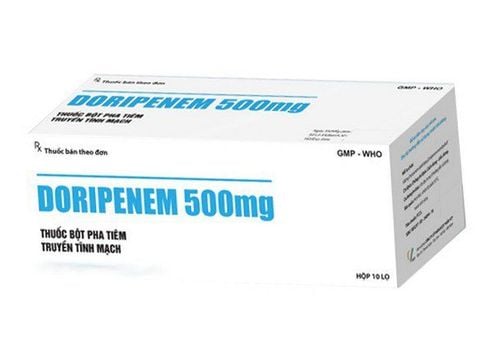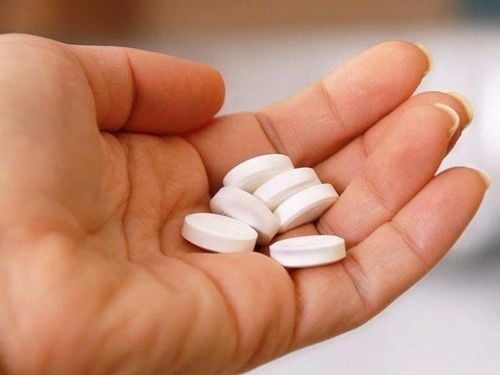This is an automatically translated article.
Phenobarbital 10% is an anticonvulsant, barbiturate class, that potentiates and/or mimics the synaptic inhibitory effects of gamma aminobutyric acid (GABA). Patients can refer to more information about the notes when using Phenobarbital 10% in the following article.1. What are the uses of Phenobarbital?
1.1. What is Phenobarbital 10%? Phenobarbital 10% belongs to the group of anticonvulsants, sedatives, and hypnotics. The drug has registration number VD-16785-12, manufactured by Danapha Pharmaceutical Joint Stock Company - Vietnam.
Phenobarbital 10% includes the following ingredients:
Main active ingredient: Sodium phenobarbital with a content of 200 mg. Excipients: Sodium hydroxide, Propylene glycol, benzylic alcohol, absolute ethanol and distilled water for injection. Phenobarbital 10% is prepared in the form of a syringe with a capacity of 2ml, a box of 20 glass ampoules. Phenobarbital 10% is recommended from infants to adults.
1.2. What is Phenobarbital 10% used for? Phenobarbital 10% is a prescription drug used by doctors in the following cases:
Seizures (except minor seizures): Major seizures, myoclonic seizures and partial seizures. Prevention of recurrent febrile convulsions in young children. Neonatal jaundice. People with congenital incongruent hyperbilirubinemia, congenital non-hemolytic anemia and in patients with chronic intrahepatic cholestasis. Contraindications:
Patients who are allergic to the main active ingredient Phenobarbital Sodium or any of the excipients of Phenobarbital 10%. Severe respiratory failure, difficulty breathing or airway obstruction. Porphyrin metabolism disorders. Severe liver or kidney failure.
2. Usage of Phenobarbital 10%
2.1. How to use Phenobarbital 10% Phenobarbital 10% is used by intramuscular injection, intravenous injection or intravenous infusion.
2.2. Dosage of the drug Phenobarbital 10% Adults:
Anticonvulsants: Dose 100 - 320mg, repeat if necessary until a total dose of 600mg / 24 hours. Status epilepticus: 10 - 20 mg/kg intravenously, repeat if necessary. Sedation: Dose 30 - 120mg / day x 2 or 3 times. Before surgery: Dose 130 - 200mg, 60 to 90 minutes before surgery. Sedation: Dose of 100 - 325mg. Children:
Anticonvulsants: Initial dose: From 10 - 20mg/kg, 1 injection (loading dose or loading dose). Maintenance dose: From 1 to 6mg/kg/day. Status epilepticus: Slow intravenous injection (10-15 minutes) 15-20mg/kg. Sedation: From 1 to 3mg/kg, 60 to 90 minutes before surgery. Anti-hyperbilirubinemia: 5-10 mg/kg/day, in the first few days after birth. Note: Elderly and debilitated patients may experience excitability, confusion or depression with usual doses. In these patients the dose of Phenobarbital may need to be reduced by 10%.
Handling when missed dose:
Phenobarbital 10% is taken by medical staff, so missed doses can be minimized.
Treatment of overdose:
Symptoms
When overdosing, phenobarbital causes central nervous system depression from sleep to deep coma and then death. In addition, respiratory depression can lead to Cheyne-Stokes breathing, central hypoventilation, cyanosis, hypothermia, loss of reflexes, tachycardia, hypotension, and decreased urination. Patients with severe overdose often have the typical shock syndrome: slow breathing, collapse, respiratory arrest and possibly death. Serious complications that can be fatal include pneumonia, pulmonary edema, and kidney failure. In addition, other complications such as congestive heart failure, cardiac arrhythmias and urinary tract infections may occur. Management:
If the patient has just taken Phenobarbital 10% within 1 hour, gastric lavage can be performed. Administration of multiple doses of activated charcoal into the stomach via a nasogastric tube is the preferred treatment for emergency phenobarbital poisoning. Treatment of phenobarbital overdose is mainly supportive treatment to relieve symptoms, most importantly, to clear the airways, maintain respiratory, cardiovascular, renal and electrolyte functions for patients. If the patient has normal renal function, diuresis and alkalinization of the urine can be done to increase the renal excretion of phenobarbital. If the patient has severe poisoning, anuria or shock, peritoneal dialysis or hemodialysis should be performed.
3. Notes when using Phenobarbital 10%
Patients with a history of alcoholism, drug addiction, kidney failure, old age, long-term use of phenobarbital may cause drug dependence. Phenobarbital 10% should not be stopped abruptly in patients with epilepsy, those who are pregnant and lactating, and patients with depression. Phenobarbital crosses the placenta. When phenobarbital is used to treat epilepsy in pregnant women, there is a risk of multiple effects on the fetus (hemorrhage; birth defects (2 to 3 times higher than in non-phenobarbital users)) and drug dependence. Therefore, special care should be taken when deciding to use this drug for this population. Continue to use antiepileptic drugs during pregnancy at the lowest dose that can control seizures. Remember that folic acid supplements during pregnancy can help reduce the risk of birth defects in babies. Caution must be exercised when phenobarbital is mandatory for nursing mothers. Advise nursing mothers taking phenobarbital, especially at high doses, to monitor their infants for the inhibitory effect of the drug. If necessary, monitor phenobarbital levels in the child to avoid toxic levels. Phenobarbital may impair the mental and/or physical ability to perform potentially hazardous activities such as driving a car or operating machinery.
4. Phenobarbital 10% side effects
At therapeutic doses, Phenobarbital 10% is well tolerated. However, the process of using Phenobarbital 10%, patients may still experience side effects such as:
Common:
Body as a whole: Drowsiness. Blood: There are giant red blood cells in the peripheral blood. Neurological: nystagmus, ataxia, anxiety, excitability and confusion in the elderly. Skin: Allergic rash (common in young patients). Uncommon:
Musculoskeletal: Rickets, osteomalacia, muscular dystrophy (common in children about 1 treatment) and arthralgia. Metabolism: Impaired porphyria metabolism. Skin: Lyell's syndrome (possibly fatal). Rare:
Blood: Megaloblastic anemia due to folic acid deficiency. If you experience these symptoms, the patient should stop using Phenobarbital 10% and notify the doctor for appropriate treatment.
5. Phenobarbital 10% drug interactions
10% Phenobarbital sodium solutions must not be mixed with acidic solutions as this may precipitate phenobarbital. There are many interactions between antiepileptic drugs. In particular, the toxicity of Phenobarbital 10% may not be increased concomitantly with an increase in the antiepileptic effect. Interactions between drugs are also very variable and unpredictable, so when antiepileptic drugs are used in combination, plasma concentrations should be monitored. Plasma concentrations and clinical effects of beta-blockers (alprenolol, metoprolol, propranolol), digitoxin, disopyramid, quinidine, ciclosporin, corticoids, theophylline, doxycycline are reduced by co-administration of Phenobarbital 10%. Phenobarbital can make oral contraceptives less effective. The effect of anticoagulants is reduced when phenobarbital is co-administered. Decreased plasma phenobarbital concentrations may reduce the effect of folic acid. The dose of phenobarbital must be adjusted when taking folic acid supplements. The hematological toxicity of methotrexate is increased because dihydrofolate reductase is more strongly inhibited with co-administration of phenobarbital. Patients with a history of hypothyroidism are at risk for hypothyroidism when co-administering phenobarbital and levothyroxine. Imipramine-type antidepressants may increase the risk of generalized seizures. The effect of phenobarbital and other barbiturates will be increased when used concurrently with other CNS depressants such as: other antidepressants, H1 antagonists, benzodiazepines, clonidine, morphine derivatives, neuroleptic agents and anxiolytics.
6. How to store Phenobarbital 10%
The shelf life of Phenobarbital 10% is 24 months from the date of manufacture. Store Phenobarbital 10% in a cool, dry place, at a temperature not exceeding 15 - 30°C, in its original packaging and out of direct sunlight. Do not put Phenobarbital 10% in the refrigerator. Keep Phenobarbital 10% out of reach of children and pets Above is all information about Phenobarbital 10% drug, patients need to carefully read the instructions for use, consult a doctor / pharmacist before using. Absolutely do not arbitrarily buy Phenobarbital 10% at home because there may be unwanted side effects.
Please dial HOTLINE for more information or register for an appointment HERE. Download MyVinmec app to make appointments faster and to manage your bookings easily.













